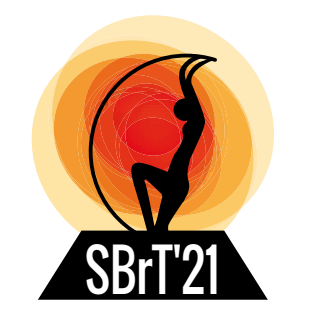
XXXIX Simpósio Brasileiro de Telecomunicações e Processamento de Sinais
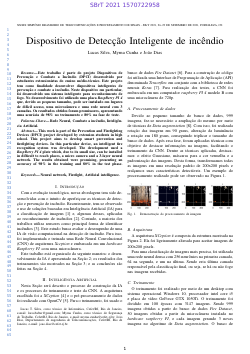
Intelligent fire detection device
Lucas Tejedor da Silva, João T Dias, Myrna Cunha
DOI: 10.14209/sbrt.2021.1570722958
Keywords: Neural network Firefight Artificial intelligence
Abstract
This work is part of the Prevention and Firefighting Devices (DPCI) project developed by extension students in highschool. This project aims to develop smart prevention and firefighting devices. In this particular device, an intelligent fire recognition system was developed. The development used a RaspBerry PI 4 plate which, due to its small size, can be installed in difficult to reach places, a micro camera and a 3-layer neural network. The results obtained were promising, presenting an accuracy of 98% in the training and 80% in the test phase.Download
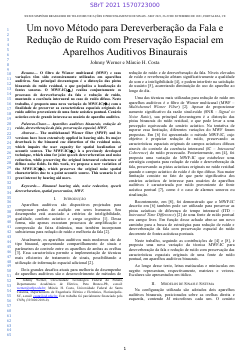
Um novo Método para Dereverberação da Fala e Redução de Ruído com Preservação Espacial em Aparelhos Auditivos Binaurais
Johnny Werner, Marcio H Costa
DOI: 10.14209/sbrt.2021.1570723000
Keywords: Aparelhos auditivos binaurais redução de ruído dereverberação da fala preservação espacial
Abstract
The multichannel Wiener filter (MWF) and its versions have been extensively applied in hearing aids. Its major drawback is the binaural cue distortion of the residual noise, which impairs the user capacity for spatial localization of acoustic sources. The MWF-IC(phi_u) is a previously developed technique, which aims for joint speech dereverberation and noise reduction, while preserving the original interaural coherence of diffuse noise fields. In this work, we propose a new variation of the MWF-IC(phi_u), which preserves the original noise spatial characteristics due to an acoustic point source. This scenario is of great interest by hearing aid users.Download
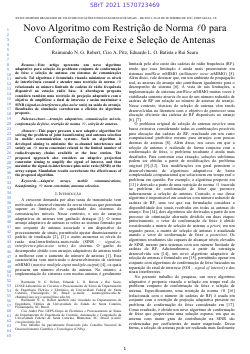
Novo Algoritmo com Restrição de Norma l0 para Conformação de Feixe e Seleção de Antenas
Raimundo Robert, Ciro André Pitz, Eduardo L. O. Batista, Rui Seara
DOI: 10.14209/sbrt.2021.1570723469
Keywords: Adaptive arrays Mobile communications Beamforming l0 norm constraint
Abstract
This paper presents a new adaptive algorithm for solving the problem of joint beamforming and antenna selection in mobile communication systems. Such an algorithm is developed aiming to minimize the co-channel interference and satisfy an l0 norm constraint related to the limited number of radio-frequency chains available at the base station. The proposed approach also considers an adaptive projection constraint aiming to amplify the signal of interest, and thus maximize the signal-to-interference-plus-noise ratio (SINR) at the array output. Simulation results corroborate the effectiveness of the proposed algorithm.Download
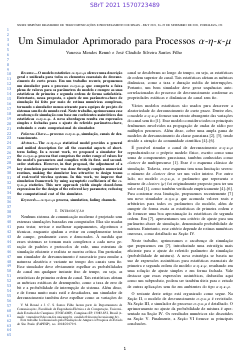
Um Simulador Aprimorado para Processos α-η-κ-μ
Vanessa Mendes Rennó, José Cândido Silveira Santos Filho
DOI: 10.14209/sbrt.2021.1570723489
Keywords: processo α-η-κ-μ simulação canais de desvanecimento
Abstract
O modelo estatístico α-η-κ-µ oferece uma descrição geral e unificada para todos os elementos essenciais do desvanecimento de curto prazo. Em um trabalho recente, propusemos um simulador para o processo α-η-κ-µ que comporta a faixa plena de valores para os parâmetros do modelo e cumpre as suas estatísticas de primeira e segunda ordens de forma satisfatória. Entretanto, nessa proposta, o ajuste de um parâmetro-chave de simulação foi feito por meio de rotinas numéricas complexas, tornando o simulador menos atraente para equipes de projeto de sistemas sem fio do mundo real. Neste trabalho, aprimoramos esse arcabouço de simulação com base em coeficientes assintóticos das estatísticas α-η-κ-µ. A nova abordagem resulta em expressões simples e fechadas para o ajuste do referido parâmetro-chave, reduzindo o custo computacional do simulador.Download
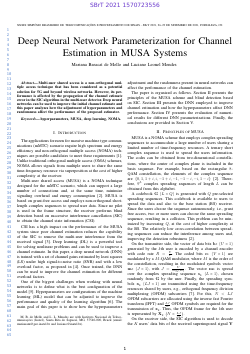
Deep Neural Network Parameterization for Channel Estimation in MUSA Systems
Mariana Baracat de Mello, Luciano Leonel Mendes
DOI: 10.14209/sbrt.2021.1570723556
Keywords: hyperparameters MUSA deep learning NOMA
Abstract
Multi-user shared access is a non-orthogonal multiple access technique that has been considered as a potential solution for 5G and beyond wireless networks. However, its performance is affected by the propagation of the channel estimate error in the SIC algorithm in the multi-user detector. Deep neural networks can be used to improve the initial channel estimate and this paper analyzes how the adjustment of hyperparameters and randomness affect the performance of the proposed estimator.Download

Reconhecimento de Padrões Speckle baseado em Textura para Sensoriamento a Fibra Óptica
Ingrid A. Reis, Evandro Salles, Camilo Arturo Rodriguez Diaz, Arnaldo Leal Junior, Anselmo Frizera
DOI: 10.14209/sbrt.2021.1570723621
Keywords: Extração de características Análise de Textura Speckle Aprendizado de máquina
Abstract
Resumo-Neste trabalho é apresentado um sistema de classificação, baseado na textura do padrão speckle, para determinação de 5 regiões em que uma fibra óptica é perturbada mecanicamente. É realizado um pré-processamento das imagens adquiridas experimentalmente, utilizando dois diferentes descritores de textura, o Local Binary Pattern (LBP) e a Gray Level Co-occurrence Matrix (GLCM), os quais são empregados em uma Rede Neural Artificial. Os resultados mostram que tanto o LBP quanto a GLCM foram capazes de classificar a localização da deformação, atingindo 99,67% de acurácia com 250 características e 83,47% com 16 características, respectivamente. Palavras-Chave-Extração de características, Análise de Textura, Speckle, LBP, GLCM, Redes Neurais Abstract-This work presents a classification system, based on the texture of the speckle pattern, to determine 5 different regions in which an optical fiber is mechanically perturbed. A pre-processing of experimentally acquired images is performed using two different texture descriptors, the Local Binary Pattern (LBP) and the Gray Level Co-occurrence Matrix (GLCM), and inserted into an Artificial Neural Network. The results show that both LBP and GLCM were able to classify the location of the deformation, reaching 99.67% accuracy using 250 features and 83.47% accuracy using 16 features, respectively.Download

Sistema Classificador de Pavimentação Utilizando Acelerômetros e Máquina de Vetores de Suporte
Filipe Do Ó Cavalcanti, Waslon T. A. Lopes, Fabricio Braga Soares de Carvalho
DOI: 10.14209/sbrt.2021.1570723968
Keywords: máquina de vetores de suporte acelerômetros aprendizado de máquina pavimentação
Abstract
Este artigo apresenta o desenvolvimento de um sistema robusto para classificação de pavimentação, fazendo uso de uma Máquina de Vetores de Suporte (SVM - Support Vector Machine) e o processamento de dados obtidos a partir de acelerômetros montados em um veículo. Os dados obtidos em um trajeto urbano foram separados em segmentos e destes foram extraídas métricas, utilizadas no treinamento da SVM. O sistema foi capaz de classificar os dados entre asfalto ou paralelepípedos com 97% de precisão.Download

Classificação Automática de Modulações DP m-PSK e DP m-QAM em Receptores Ópticos Coerentes Flexíveis
Antonio M. C. Pereira, Rafael S Furtado, Diego A. Amoedo, Myke D. M. Valadão, Celso Barbosa Carvalho, André L. A. Costa, Waldir Silva
DOI: 10.14209/sbrt.2021.1570724020
Keywords: Classificação automática de modulação Aprendizado de máquina Redes ópticas
Abstract
With the growing demand for higher transmission rates, an alternative is to seek efficient ways of use for the resources in optical networks. Technologies such as flex grid, dynamically allocate the channels accordingly to the network demands. Automatic modulation classification techniques provide information that help to define some transmission parameters such as, ideal modulation format for the transmission medium, frequency and phase recovery algorithms, single or multi carriers transmissions, error correction algorithms and amplifiers gain. This paper presents a research about automatic modulation classification in flexible optical coherent receivers. To accomplish that was used a back-to-back setup between a receiver and transmitter. Other than that, were generated 93,600 signals modulated as DP m-PSK and DP m-QAM, with thirteen noise levels. Lastly, the results show that is a promising research.Download
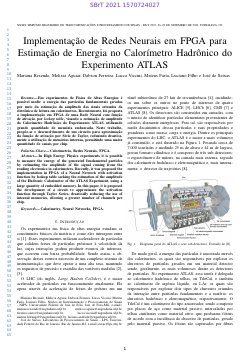
Implementação de Redes Neurais em FPGA para Estimação de Energia no Calorímetro Hadrônico do Experimento ATLAS
Mariana Resende, Melissa Santos Aguiar, Dabson Ferreira, Lucca Viccini, Mateus Faria, Luciano Filho, José de Seixas
DOI: 10.14209/sbrt.2021.1570724027
Keywords: Calorimetry Neural Networks FPGA
Abstract
In High Energy Physics experiments it is possible to measure the energy of the generated fundamental particles by estimating the amplitude of the signal coming from the reading electronics in calorimeters. Recently, it was proposed the implementation in FPGA of a Neural Network with activation function by lookup table seeking the estimation of the amplitude of the Hadronic Calorimeter of the ATLAS Experiment, using a large quantity of embedded memory. In this paper, it is proposed the development of a circuit to approximate the activation function through Taylor Series, drastically reducing the use of internal memories, allowing a greater number of channels per chip.Download
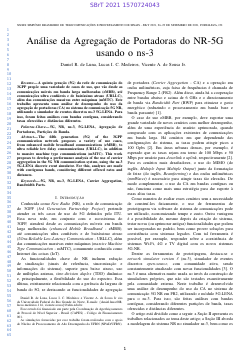
Análise da Agregação de Portadoras do NR-5G usando o ns-3
Daniel R. de Luna, Lucas I. C. Medeiros, Vicente A. de Sousa Jr.
DOI: 10.14209/sbrt.2021.1570724043
Keywords: 5G NR Agregação de portadoras ns-3
Abstract
The fifth generation (5G) of the 3GPP communication network proposes a variety of use cases, from enhanced mobile broadband communications (eMBB), to ultra reliable low delay communications (URLLC), in addition to massive machine type communications (mMTC). This work proposes to develop a performance analysis of the use of carrier aggregation in the 5G NR communication system, using the ns-3 5G-LENA discrete event simulator. For this, analyzes are made with contiguous bands, considering different offered rates and distances.Download